|
Bourne Abbey
Church of England
Primary
Academy
(FORMERLY THE ABBEY PRIMARY SCHOOL)
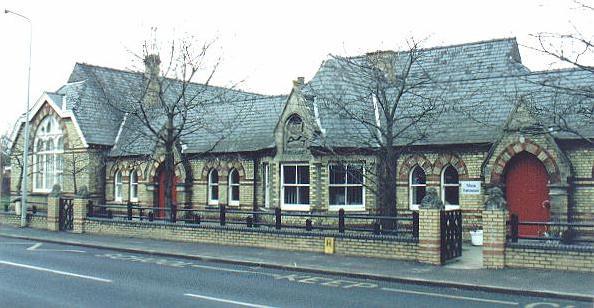
Education available to all is a comparatively recent innovation in England and it was not until the Education Act of 1870 that elementary schools were built and run by the state and local school boards appointed to supervise their running and empowered to levy a rate for this purpose. This was a major social change that has evolved into what we know today as the state education system although conditions have drastically changed since Victorian times.
In December 1874, a board of five members was created in Bourne consisting
of John Roberts, the Rev William Orton (Baptist), Thomas Mays (for the
dissenters), Charles Glover, Stephen Andrews and John Bell, clerk, and its first task was to begin the construction of
a new elementary school. The board purchased an orchard in Star Lane [now
Abbey Road] from Mrs Matilda Arnold at a cost of £125 per rood for the
building of a school and a master's residence.
Thirteen architects submitted designs for
consideration but the contract was awarded to Charles Bell of 4 Union
Court, Old Broad Street, London, and the construction was carried out by
Messrs Priest of Grantham at a cost of £3,727. It opened in July 1877 as the
Star Lane Board School with room for 480 children, both boys and girls.
The premises became the main centre for elementary education in the town, superseding the old National School in North Street although these premises were used for a period to provide technical education for selected pupils supervised by a local committee working
in conjunction with the county council. John Derry was appointed
headmaster of the boys' school at a salary of
£80 a year and Miss Readwin, headmistress of the girls' and infants'
school.
It is worth noting that the village school at Twenty, four miles east of Bourne, was built in 1876 at a cost of £1,174 with room for 60 pupils, by the same architect and builder who also used similar distinctive yellow bricks and blue slate popular for institutional buildings during the mid-19th century. The average attendance at the new Board School, as it was known, during the ensuing years was 350 but numbers steadily increased to 500 by the turn of the century and the premises were enlarged to accommodate the additional children in 1892 and again in 1894. There was a further extension in 1901 with the aim of eventually providing classroom space for 700 children although this turned out to be an optimistic forecast. In
September 1930, the school was renamed Bourne Council School with
departments for juniors and a senior department for children aged 11
plus..
Today, the Abbey Primary is a large, mixed nursery, infant and junior school although the original buildings of 1877 can still be seen with separate entrance doors marked Boys and Girls while the stone tablet bearing the crest and the motto
Vigila et ora or Watch and Pray remains on the front wall. The
premises however have been extensively modernised over the years with new
extensions built during the early 1960s and mid 1980s and a further
addition of three infant and two junior classes and a technology room was
completed in the 1990s.
Apart from the well equipped classrooms,
there are two large halls used for assemblies, physical education and
drama lessons, concerts and musical presentations while the school also
has an active Kindergarten and extensive hard and grassed areas for play
and outdoor games. The current IT provision is among the best in
Lincolnshire with an interactive DVD as part of the school’s prospectus
and pupils have their own web site on the Internet of a very high quality,
well designed and easy to read and navigate and additional pages are being
added showing the work of each year group and community links.
|
Visit to the school by Kenneth Clarke,
Secretary of State for Education and Science, on Tuesday 11th June
1991, to announce that the school's application for grant maintained
status had been approved.
He is pictured here (centre) with
two of the school's governors, Councillor Don Fisher (left) and
Councillor John Wright, who was also vice-chairman. |
 |
There was a landmark in the history of the school in June 1991 when it was
named as the first primary in Britain to become grant maintained and
pupils and staff received a surprise visit from the then Secretary of
State for Education Kenneth Clarke to mark the occasion, and has since
become a foundation school, a far cry from those Board School days of a
century ago.
The school celebrated 130 years of its
history in 2007 with the raising of a new flag. It was unfurled on a
flagpole in the playground at a special ceremony on Wednesday 26th
September by John Kirkman, chairman of the governors, with the entire
school in attendance. Head teacher, Cherry Edwards, told pupils: "This has
been a school for 130 years and today you are making history." The flag
was suggested by school governor Paul Gandy and many people were involved
in its planning including members of the school council, Mrs Millie Deakin, grandmother of one of the pupils, local firm Bourne Services,
school governor Mrs Jean Joyce and the Parent-Teacher and Family Association
(PTFA).
In December 2007, the highest accolade
possible was received from Ofsted (the Office for Standards in Education),
the government body responsible for the regular checks on the nation's
schools. Inspectors had visited the Abbey Primary School the previous
month and their report gave it a top grading of "outstanding" in all
departments. For a large primary school with 620 pupils to achieve such a
glowing report was regarded as an incredible achievement and a reflection
not only on the tremendous job by school staff, but also on the boys
and girls who attend as well as the governors who were also singled out
for similar praise.
Head teacher Cherry Edwards was delighted. “We are exceptionally
proud of our school and what has been achieved", she said. "Above all we are proud of
our pupils. They are the stars of the school and of this report. The
comments in the report pay tribute to their joy and love of learning.”
|
 |
|
Head teacher Cheryl Edwards with school
governors (left to right) Paul Gandy, Kevin Wright, Duncan Pickering
and the chairman, John Kirkman, pictured after the Ofsted
announcement in December 2007 and (below) jubilant pupils with head
teacher Cheryl Edwards and John Kirkman following the announcement
in December 2010 that the school had been granted academy status. |
|
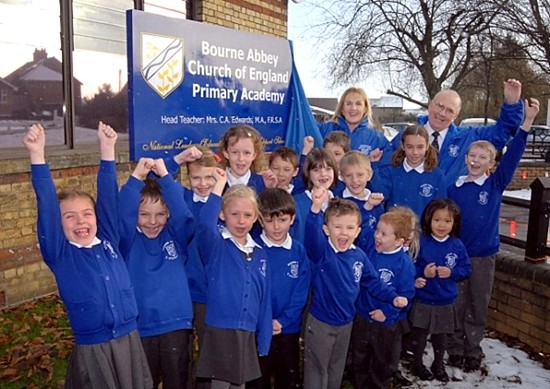 |
The school was one of only twelve in Lincolnshire to receive an
"outstanding" rating and the inspection report was a catalogue of
compliments to staff, governors and pupils. It said: “Pupils behave
extremely well and make the most of what the school offers. They look
forward to school, bring a great sense of goodwill and a desire to be part
of everything. Pupils make exceptional progress overall because the
curriculum is so well organised and the teaching excellent with Mrs
Edwards showing exceptional leadership. The only area found for
improvement was that the boys could be even better writers."
Chairman of the governors, John Kirkman, was suitably jubilant. "We are
absolutely delighted that the inspection has resulted in a report that
publicly recognises the outstanding ethos and education provided at the
school", he said. "It bears out the confidence we have in the leadership
and vision of the head teacher, Mrs Cherry Edwards, and the hard work,
skills and passionate commitment of the whole leadership team, teachers,
support staff, parents and governors who have brought us to the stage
where Ofsted describes us as an outstanding school that gives excellent
value for money.”
The grading was regarded locally as a welcome development, not only for
the school but also for Bourne, a reflection on the quality of life and
another very good reason why so many couples with young families would
wish to move there and live in such large numbers.
In 2008, the school changed its name and
status to the Bourne Abbey Church of England Primary School and in 2010
major extensions were completed at a cost of £700,000 to provide a new
block of three classrooms and a new kitchen and canteen facilities. The
official opening was performed on Monday 27th September by Prince Edward,
Earl of Essex, who cut a ceremonial ribbon and unveiled a commemorative
plaque. The extensions also meant that the last of the school's mobile
classrooms could be phased out.
There was a further major change in
December 2010 when the school became the first in Lincolnshire to be
granted academy status under new government education policy. This means
that it is now publicly funded but free from local authority and national
government control with other associated freedoms including the right to
set pay and conditions for staff, the style of curriculum and the ability
to change the length of term time and even school days. In other words,
totally independent and new signs have already gone up announcing the
change of status to the Bourne Abbey Church of England Primary Academy.
It was, said Mrs Edwards, the beginning of a new chapter for the school.
“We are absolutely delighted to embrace this opportunity which will enable
us continue to provide the very best education for our children. There
will be no drastic changes but it will secure our future as an autonomous
establishment, running our own payroll and finances with the governing
body in charge of employment.”
In June 2014, Mrs Edwards was made an OBE
for services to education in the Queen's Birthday Honours. Then, three
months later, in September 2014, the school was selected to become a
National Teaching School and would take a leading role in recruiting and
training new entrants in the profession, identifying leadership potential
and providing support for other schools. The scheme was introduced in this
country in 2011 to provide initial teacher training and professional
development opportunities for teachers at all stages of their career.
Charlie Taylor, the Chief Executive of the National College for Teacher
Training, said that the school had been recognised as a centre of
excellence ion its area with an outstanding performance and a track record
of raising standards through supporting other schools.
|
THE ABBEY PRIMARY SCHOOL IN PAST TIMES |
|
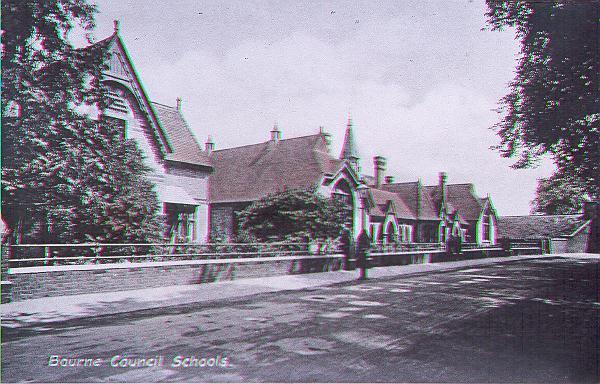 |
|
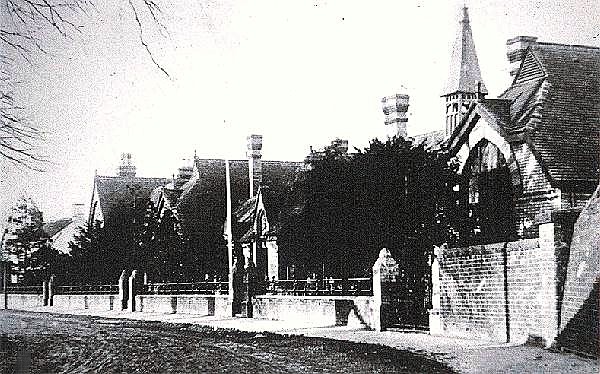 |
|
 |
|
The Abbey Road
School in 1900 (top). It was then really three schools, one each
for boys, girls and infants, and from 1903, it was for several
years the only major school in Bourne. The bottom picture from a
postcard by Ashby Swift shows the school in 1910 and a timetable of the school
year is reproduced below. |
|
ABBEY ROAD SCHOOL YEAR 1900
Extracts from the boys' school log for 1900:
Staff: Joseph J Davies, Chief master
T H Harrison, about 50 pupils
F Crickard, about 50 pupils, teaches Standards 6 & 7
Mrs C Homsey, about 50 pupils, teaches Standard 1
Miss D Davies, about 50 pupils
Edward Billard of Dyke, pupil teacher, 2nd year.
Albert Lambert and Harry Goy candidates for pupil teacher.
Friday 5th Jan, 194 present including those up from the infants.
Standard 0 introduced for more backward boys!
Friday 2nd March, half day holiday for relief of Ladysmith.
Thursday 10th April, holiday, school needed for UDC Election.
Tuesday 1st May, half day holiday am (pm attendance poor!).
Monday 14th May, holiday for May statute fair.
Monday 21st May, holiday for relief of Mafeking.
Thursday May 31st, half holiday, report of capture of Pretoria.
Broke up for Whit week (4th-8th June).
Thursday June 21st, half holiday. Baptist Sunday School treat.
Wed. July 4th, half holiday, Wesleyan Sunday School treat.
Monday July 23rd, holiday for school treat.
Friday August 10th, broke up for harvest holiday.
Monday October 1st, reassembled, holidays extended one week
as repairs to school not finished.
Friday October 26th, holiday for the fair.
Friday November 2nd, circus in town, attendance very poor.
Friday December 21st, broke up until Tuesday 1st Jan 1901. |
|
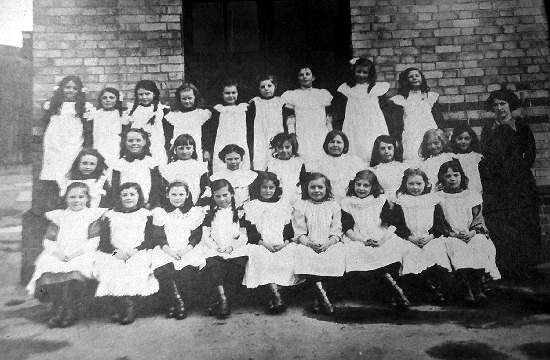 |
|
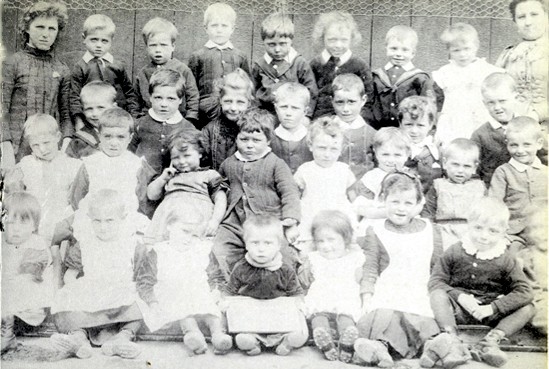 |
|
Boys and girls pose for a group photograph in their
Sunday best, all wearing boots and white smocks or pinafores to protect their
clothes during the day (top), a picture taken at the school circa
1885. The teachers in the girls' school at that time were Miss
Clara Ward, headmistress, and Miss Emma Blaxter, infants'
mistress, although it is not known which of them is in the
photograph on the right. |
|
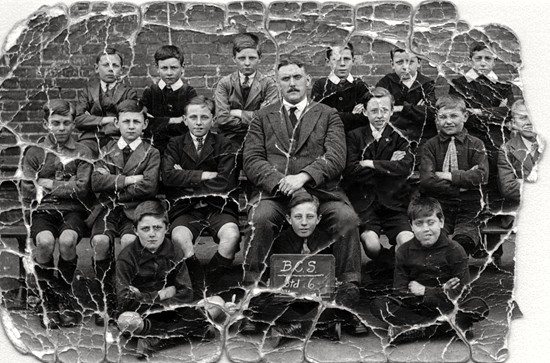 |
|
A remarkable but rather tattered school
photograph that has survived from circa 1918 although no names are
known of either the schoolteacher or the pupils from Standard 6. |
|
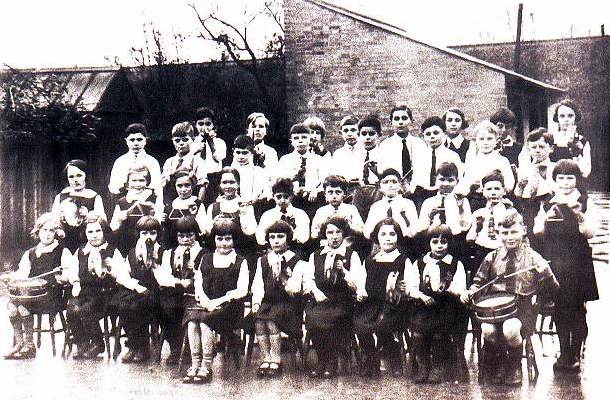 |
|
This photograph taken in the school
playground in 1936 shows pupils of the senior class, aged 10-11,
who were also members of the percussion band and carrying their
instruments with the triangle and kettle drum much in evidence.
The picture was supplied by Trevor Pool of Halifax, Yorkshire, who
is in the group, second from the left in the extreme back row. The
headmaster at this time was Mr Harry Goy and the mistress in
charge of this class was Mrs Moss. Other names of pupils that he
remembers are Mary Cliffe (seated on the left of the front row),
Sandall, Godfrey, Dunn, Betts, Cox, Maddison, Pick and Bloodworth. |
|

|
|
Children from towns and cities under attack
from enemy bombing during the Second World War (1939-45) were
moved to Bourne to live with local families. The evacuees came
mainly from the Hull area and this group attending the Abbey Road
school were photographed
circa 1943. |
|
 |
|
Teachers and pupils at Bourne Abbey Primary
School in 1946 |
|
FROM THE
ARCHIVES |
|
SCHOOL BOARD: The usual monthly meeting of this
Board was held on Tuesday last, the Rev W Orton in the chair. A
woman named Frisby attended before the Board and complained that the
mistress of the Girls' School had flogged her child very severely,
but after investigating the affair the Board were unanimous in their
opinion that the child received no more correction than was
absolutely necessary. - news report from the Grantham Journal, Saturday 8th November 1879.
SAD AFFAIR: On Tuesday last, a very sad mishap occurred to Thomas
Frost, aged about eight years, son of Mr George Frost, Excise
officer, of this town. It appears that the little fellow (together
with other boys) was on his way to the Board School and when in Star
Lane, a boy named Blake came up behind him and thoroughly filled one
eye with a mixture known in the building trade as putty. He was
immediately taken home and Dr [James Burdwood] Watson called in, who
did all that was in his power to alleviate the boy's sufferings and
keep down the inflammation but it is feared that he will lose the
sight of one eye entirely. - news report from the Grantham
Journal, Saturday 21st August 1880. |
|
PRESENTATION ON MARRIAGE
Miss Emma Blaxter, headmistress of Bourne Board
Infants' School, was on Friday, on leaving for her marriage,
presented with a handsome marble timepiece, the gift of the
scholars; and a silver cruet, a case of carvers, silver mounted, and
half a dozen silver tea spoons, the gift of the members of the
school board and her fellow teachers. The articles were supplied
through Mr J Ellicock, South Street. There were also numerous
beautiful presents from friends. - news report from the Spalding
Free Press, Tuesday 17th August 1897. |
|
THE BIRTHDAY SIXPENCE
|
In June 1905, each pupil at the school was handed a
slotted card with a sixpence attached that had come from Burghley
House to mark the birth of David George Brownlow Cecil, Lord
Burghley, who subsequently became the 6th Marquess of Exeter. One of
the boys was George Darnes who in later
years remembered the gift. |
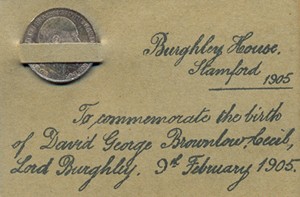 |
|
"Some of my classmates, to whom sixpence was
real wealth in those days, chose to spend it on sweets on the way
home. But I decided to keep mine", he said. George won a scholarship to
Stamford School, the only one in his class of 30 pupils to do so,
and after leaving, joined he staff of T W Mays and Sons Ltd,
eventually becoming managing director of one of their companies. He
died in 1982, aged 83, leaving the coin to his daughter, Mrs Jean
Booth, of Coggles Causeway, Bourne.
The occasion was recorded in the school log book on June 24th as
follows: "This afternoon, Mr J B Shilcock distributed to the
children presents kindly sent by the Marquess of Exeter to
commemorate the birth of his heir, David, Lord Burghley. The
present to each of the 295 boys was a commemorative card with a
new sixpence, fresh from the mint. Mr Shilcock gave a nice address
and the boys were greatly delighted with the presents." |
|
|
THIRTY-FIVE YEARS IN ONE SCHOOL
When the Bourne Boys' Council School broke up
on Wednesday for the Christmas holidays, Mr T W H Harrison
terminated his long period of service at the school. Mr Harrison
commenced teaching at the school in 1888 and is now retiring on
superannuation. Before the school was dismissed, the headmaster, Mr
H Goy, presented Mr Harrison with a barometer for which the scholars
and staff contributed, and he referred to the long association of Mr
Harrison with the school and wished him a long and happy retirement.
Mr Harrison suitably acknowledged the gift.
- news item from the Stamford Mercury, Friday 21st December 1923. |
REVISED AUGUST 2016
See also
The school log books
Punishment book
Death in the playground
The Hull evacuees
Miss Urith Dent
A royal visit
A change of name and status

Go to:
Main Index Villages
Index
|












